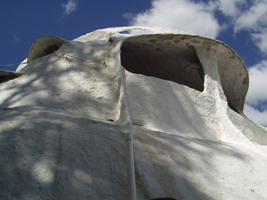
Roofs tend to be one of the most expensive, most difficult parts of building a home. Most conventional roof systems are very expensive and utilize energy intensive materials. One low-tech alternative is nylon cement roofs, which have been pioneered for over 30 years by Bill Birdsall.
Bill’s website shows how he built his house and other structures in Puerto Rico. These buildings have stood the test of time in a rainy climate. The building process involves gradually adding thin layers of cement to recycled fine mesh fishnet. Think of it as ferrocement without the ferro (steel).
In comparison, expanded metal lath that’s typically used in ferrocement is almost as sharp as razor blades. Not fun to work with at all. But fishnet is light, soft, comes in big pieces and won’t rust. Recycled fishnet should last for many years embedded in cement (it has for Bill), and can be obtained for free. Fishing companies replace their nets before they’re completely worn out. For safety’s sake always use nets that are still strong.
Nylon cement tech article
Nylon cement pics
Bill Birdsall Home page
Hog tie tool speed ups fastening fishing net to rebar
Tirolessa mortar sprayer

Either the queen gives us a building lab with students or we course in Thailand shutting down farm from 50 acres to 3 ..for experimental purpose farming. Architecture big focus….
Could you elaborate please?
Thank you so much for the link. I have been searching for photos of what I want to do. I am wondering about the dilution of the magnesium cement. I’m working with a basic recipe for the magnesium oxide, mono potassium phosphate and water with the ratio of 5: 4: 3.5 but wonder for dipping the cloth in the diluted combo should I double the water? In my experiments so far the more water the longer it takes to dry. Any advice would be much appreciated as deviating from the tried and try is proving to be expensive. Thanks again.
I’m gathering the material to make my ceramicrete structure in n. cal. I bought 100 yards of material online that I thought was cotton based but it turns out to be nylon rip stop. I am worried that it will not bind to the ceramicrete as I have read that it does not bind to plastic. I am on a very tight budget and have to wait to order the phosphate until payday to run the experiment… what do you think… anyone use nylon dipped into diluted ceramicrete?
Test a small piece and see how it works. Thinkenstein uses nylon fishing net to make ferrocement structures. http://www.instructables.com/id/Put-a-Rounded-Roof-on-a-Square-House/
I tried something similar (just one quick test) and my materials did not bond. Mesh size, etc. effect bonding.
You mention Bill Birdsall’s website as having info on how he built his house–but apparently you forgot to link to that website.
For any who want to look into it farther, it’s at http://www.angelfire.com/in2/manythings/
David
Got it, thanks.
From Michael Collins:
I noticed you had a gap in the nylon cement roofs as I have had a great deal of experience with these roofs for example the roofs of the house I built in Todos Santos are good examples some how you mixed up those roofs with the cermicrete but no importa as they are made the same way and note that the ceramicrete roof is made the same way with fiber and nylon fishing net…..we added many improvements to the old Birdsail roofs with my young group of mexican architects we are working on carrying these systems way farther……the issue was the insulation of the roof……now we have gone through many types of insulation……..it is better to work up an article on this subject……with pictures and tech……Mike Collins
Hi Mike. Hope you write an article or even short blog post about what you’ve learned.